Build Or Buy? Five Sub-$500 Store-Bought Systems Compared
System Roundup: What Do You Get?
Building a system can be a complex process, especially if it's one of your first. That's why Thomas Soderstrom recently updated his classic How To Build A PC guide.
Doing it yourself isn't just about picking components and slapping them together. You can narrow down the processor interface you want to use. Then you have to pick the right complementary chipset. From there, it's all about comparing motherboards based on that platform and deciding which features are most important. The choices go on and on and on. And it's not just motherboards affected, either. Graphics cards, memory, and power supplies; they can all be found with similar specs and a handful of slight differentiators that require a fair bit of research.
In an ideal world, where system builders always had their customers' best interests in mind (rather than the highest-margin parts), pre-configured setups would include smartly-picked combinations of hardware, taking the guesswork out of the construction process.


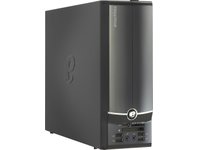

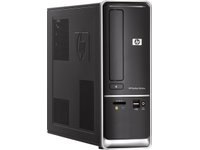
We only managed to find five different systems available under that sensitive $500 price point. Bear in mind that this was during an online shopping trip to Best Buy, too. We're not saying there isn't more selection out there, but our goal was to pull systems off the shelf in order to get a real buying experience.
| Header Cell - Column 0 | Compaq CQ5700Y | Dell i560-565NBK | eMachines EL1352-23e | eMachines EL1850-01e | HP s5704y |
|---|---|---|---|---|---|
| Price | $309.99 | $399.99 | $299.99 | $349.99 | $409.99 |
| Processor | 2.0 GHz Athlon II 170 | 3.2 GHz Pentium E5800 | 2.2 GHz Celeron 450 | 3.1 GHz Athlon II X2 255 | 3.0 GHz Athlon II X2 250 |
| Graphics | Radeon HD 3000 | GMA X4500HD | GMA X4500HD | nForce 6150SE | Radeon HD 3000 |
| Optical Drive | 12x DVD+R DVD Burner | 8x DVD+R DVD Burner | 8x DVD+R DVD Burner | 8x DVD+R DVD Burner | 12x DVD+R DVD Burner |
| Hard Drive | 500 GB 7200 RPM | 500 GB 7200 RPM | 500 GB 7200 RPM | 500 GB 7200 RPM | 500 GB 7200 RPM |
| Memory | 1 x 2 GB DDR3-1333 | 1 x 1 GB DDR3-13331 x 2 GB DDR3-1333 | 2 x 1 GB DDR3-1333 | 2 x 2 GB DDR3-1333 | 1 x 1 GB DDR3-1333 1 x 2 GB DDR3-1333 |
| OS | Windows 7 Home Premium 64-bit | Windows 7 Home Premium 64-bit | Windows 7 Home Premium 64-bit | Windows 7 Home Premium 64-bit | Windows 7 Home Premium 64-bit |
| PSU | 250 W | 300 W | 220 W | 220 W | 220 W |
| PCI | 0 | 1 | 0 | 0 | 0 |
| USB | 6 | 6 | 7 | Row 9 - Cell 4 | 6 |
| PCIe x1 | 2 | 2 | 1 | 1 | 2 |
| PCIe x16 | 0 | 1 | 1 | 1 | 0 |
The most obvious deficiency in those systems is graphics performance. Meanwhile, Paul managed to work in a Radeon HD 6850 into his System Builder Marathon setup.
Unfortunately, within this price range, you’re only going to find integrated graphics on the built-up machines. If you want to turn a brand name system into a cheap gaming PC, you need to plan for a graphics card upgrade. Five-hundred dollars doesn't go very far, but if you cap the rest of your system purchase to about $425, you should have enough to buy a Radeon HD 6670.
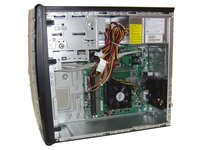
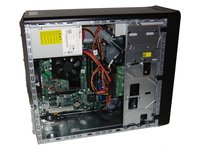

Since we ordered these systems online, we didn’t realize that the eMachines and HP desktops were microATX until after we picked them up. Online artwork isn't the best representation of scale, so it’s an unavoidable variable in our story. Fortunately, form factor alone doesn't prevent us from adding a graphics upgrade. The real problem is when top-tier manufacturers try to get fancy with their case designs. Even when we removed the brackets on AMD's Radeon HD 6670 so that we could use it in a half-height configuration, we couldn’t get the graphics card to fit in the microATX systems due to a lack of fan clearance.
Get Tom's Hardware's best news and in-depth reviews, straight to your inbox.
While Compaq's CQ5700Y is a full ATX system, it can't take an add-in graphics card because it lacks a PCIe x16 slot entirely. It does offer two PCIe x1 slots, but that's of little consolation to anyone looking for better gaming performance.
Right off the bat, Dell's offering is the only one we're able to upgrade. But even then our prospects aren't very promising. The $399 Dell i560 leaves you about $100 for a graphics card, and since the i560 uses a 300 W PSU that lacks auxiliary PCI Express power connectors, your choices narrow down to only a handful of entry-level cards unless you're also willing to buy a new power supply.
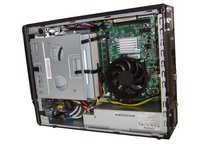

Current page: System Roundup: What Do You Get?
Prev Page Build Or Buy? Hunting For Cheap Performance Next Page BIOS And Overclocking: Now There’s Your Problem-
jeff77789 Also, on another note, the money that you have to pay just to get an operating system like Windows simply takes too much out of your budget if you are going for $500 as your max. i wouldn't suggest building unless your budget is >$550Reply -
JohnnyLucky Grandma's idea of gaming is a few rounds of Solitaire. The pre-builts will do for her.Reply -
cknobman hmmm what is up with the crappy big vendor choices only? If you ordered these online why not go with a "boutique" vendor.Reply
I just configured an iBuyPower rig for $489. It has Athlon X2 250, 4gb Ram, 500GB HDD, 500w Power Supply, Liquid cooling, Radeon 6570. For $24 more bucks I could get a 6670.
I know its not a killer machine but it puts these big box vendors to shame. -
sinfulpotato On a real budget I wouldn't get a 6850. Even more so if you are staying below 500 clams. There are power house GPUs that can be had for less then 100 dollars. My 4850 still runs strong and as shown by Tom's very own review a Athlon x4 will compete with the Phenom x4.Reply
Also if you already have windows OEM you can get it reactivated on a new PC if you get the right Microsoft rep, also lie about motherboard dieing and not replaceable... Some will choke up a code. -
lordravage I have a real problem with this article. It isn't comparing a $500 prebuilt system to a $500 home build at all. It compares 5 computers from Best Buy that range from $299 to $409, versus a $500 machine that lacks an OS, mouse and keyboard. Factor everything in and the home build costs almost TWICE as much as the cheapest competitor.Reply
I know you mentioned the discrepancies in the article, but if you aren't going to try a little harder to make a good comparison you shouldn't even make the article. Shop around online at better retailers than Best Buy, find the very best systems you can that cost about $550, THEN compare those to your own system.
I still expect the prebuilt systems to fall behind, but the article we have here isn't even a real comparison. -
deadcold94 constructive criticism but on i think its page 5 your adobe photoshop graph has a 1 instead of an 11. thanks for fixing it; when and if your do.Reply
sincerely,
Mackenzie -
JOSHSKORN If you're a serious FPS gamer, don't waste your money on a pre-build. Do the research and have a computer built for you or build it yourself. You'll spend the same price most likely and come out with a much better machine. The difference is the cost of the name brand.Reply -
cmcghee358 Why wasn't the $500 Homebuilt PC placed on the chart to show comparison?Reply
All you did was compared the systems performance and then list the Custom-built specs at the end without any benchmark comparison.
I was going to use this article for ALL of my friends to understand why they should build their own. But, since you guys compared the rainbow of feces available at Best Buy without showing the splendor that is home build, it's useless.
Come on...